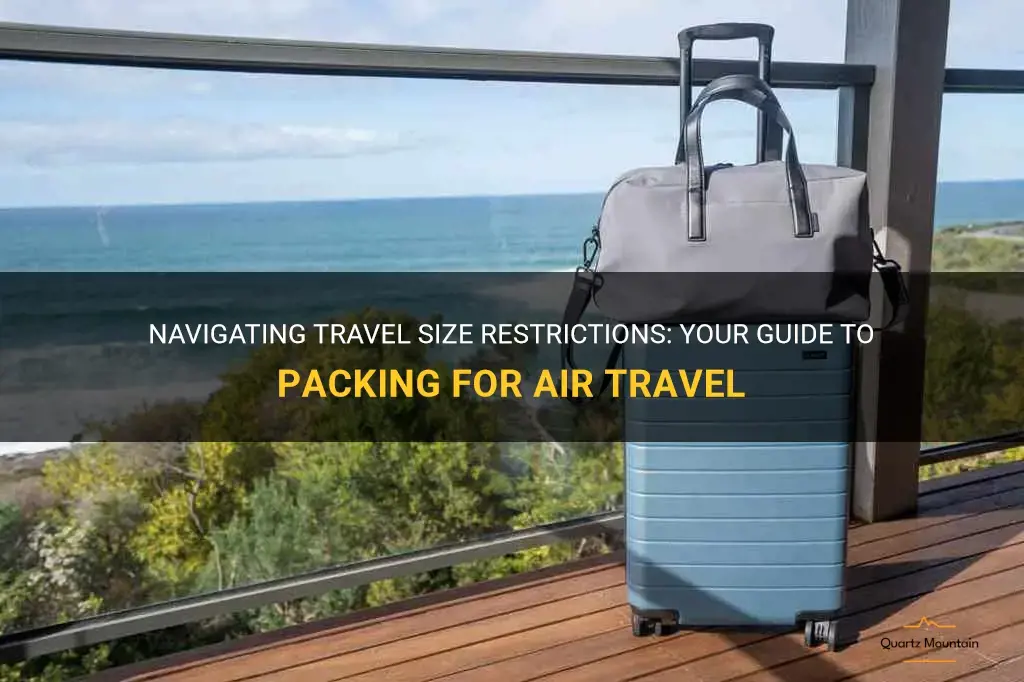
Travel size restrictions have become a hot topic in recent years as more and more people are taking to the skies for their travels. From liquid limits to allowable carry-on dimensions, these restrictions can sometimes feel like a major inconvenience. However, they serve an important purpose in ensuring the safety and efficiency of air travel. In this article, we will explore the reasons behind travel size restrictions, how they are enforced, and some tips for navigating them during your next journey. So, buckle up and get ready to learn about the ins and outs of travel size restrictions!
| Characteristics | Values |
|---|---|
| Maximum Liquid Volume | 3.4 ounces or 100 milliliters per container |
| Maximum Container Size | Containers must be 3.4 ounces (100 milliliters) or smaller |
| Total Liquid Volume | The total volume of all liquids, gels, and aerosols must fit within a single, clear, quart-sized resealable bag |
| Number of Containers | Each passenger is allowed 1 quart-sized bag containing liquids, gels, and aerosols, with no more than 4 ounces (100 milliliters) |
| Exceptions | Medications, baby formula, and breast milk are allowed in larger quantities and do not have to fit in a quart-sized bag |
What You'll Learn
- What are the current travel size restrictions for carry-on luggage on airplanes?
- Are travel size restrictions the same for all airlines, or do they vary?
- Can you bring travel-sized toiletries on an international flight?
- Are there any specific restrictions on the size or amount of liquids allowed in carry-on luggage?
- How do travel size restrictions differ for checked luggage versus carry-on luggage?

What are the current travel size restrictions for carry-on luggage on airplanes?
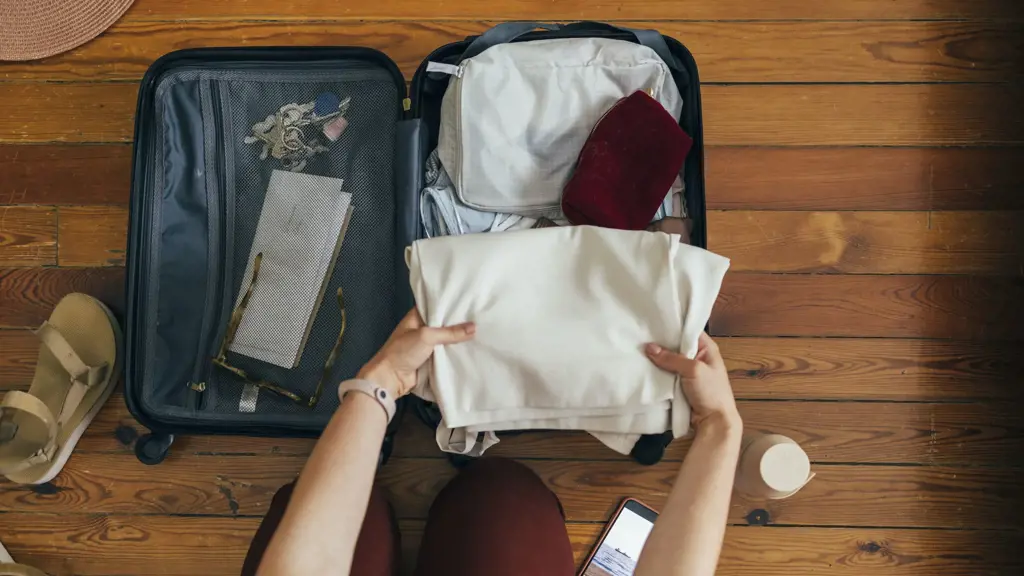
When it comes to packing for a trip, knowing the travel size restrictions for carry-on luggage on airplanes is essential. These restrictions are in place to ensure the safety and efficiency of air travel. Airlines have specific guidelines regarding the size and weight of carry-on bags, so it's important to familiarize yourself with these rules before heading to the airport.
The most common size restriction for carry-on luggage is the overall dimensions of the bag. Typically, airlines specify that the bag should not exceed 22 inches in length, 14 inches in width, and 9 inches in height. Some airlines may have slightly smaller dimensions, so it's always a good idea to check with your specific carrier. It's worth noting that these restrictions apply to the exterior dimensions of the bag, including any handles or wheels.
Weight restrictions for carry-on luggage can vary depending on the airline. Most carriers have a weight limit of around 15 or 20 pounds for carry-on bags. However, it's important to note that some airlines do not have a specific weight restriction, as long as the bag can be safely stored in the overhead compartments.
In addition to size and weight restrictions, there are also limits on the types of items that can be brought in carry-on luggage. Liquids, gels, and aerosols are subject to the 3-1-1 rule, which means they must be in containers that are 3.4 ounces (100 milliliters) or less, and all containers must fit into a single quart-sized clear plastic bag. Each passenger is allowed one bag of liquids, gels, and aerosols.
Certain items are not allowed in carry-on luggage at all, regardless of size or weight. These items include but are not limited to firearms, explosives, self-defense sprays, and sharp objects such as knives or scissors. It's important to check with your airline or the Transportation Security Administration (TSA) for a comprehensive list of prohibited items.
It's worth noting that some airlines may have additional rules or restrictions for carry-on luggage, such as limits on the number of bags or additional fees for oversized or overweight bags. It's always a good idea to check with your specific airline before packing to ensure you are in compliance with their policies.
In conclusion, the current travel size restrictions for carry-on luggage on airplanes include specific dimensions for the bag, weight limits, as well as restrictions on liquids and prohibited items. It's important to familiarize yourself with these rules and check with your specific airline to ensure a smooth and hassle-free travel experience.
Navigating BVI Travel Restrictions: Everything You Need to Know
You may want to see also

Are travel size restrictions the same for all airlines, or do they vary?
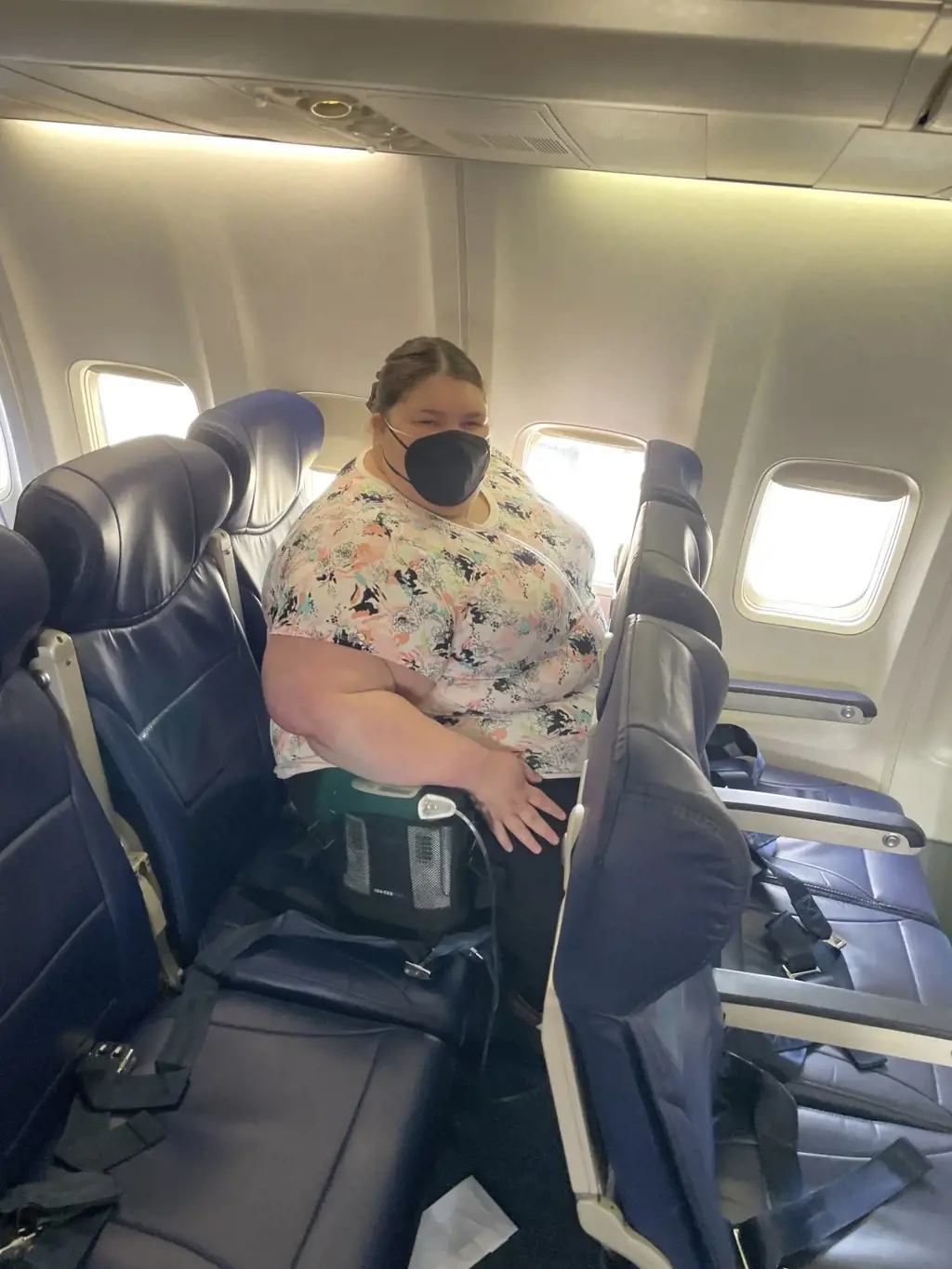
Traveling by air has become a convenient and popular mode of transportation for many people. However, when it comes to packing for a flight, one aspect that often confuses travelers is the restrictions on travel-size items. Many wonder if these restrictions are the same for all airlines or if they vary.
In general, travel size restrictions primarily apply to carry-on luggage rather than checked baggage. The restrictions are in place for security and safety reasons and are generally implemented by airport security agencies worldwide. However, it is important to note that while there are some common restrictions, there can be slight variations between different airlines and countries.
The Transportation Security Administration (TSA) in the United States has a list of rules and regulations regarding travel-size items. These rules state that any liquids, gels, creams, pastes, and aerosols must be in containers that are 3.4 ounces (100 milliliters) or less. These containers must be placed in a clear, quart-sized plastic bag and presented separately at the security checkpoint. This rule applies to all airlines operating within the United States.
Similarly, the European Union Aviation Security Regulations have similar restrictions on travel-size items. The regulations state that liquids, gels, and aerosols must be in containers that are 100 milliliters or less. These containers must also be placed in a transparent, resealable plastic bag with a maximum capacity of one liter. Airlines operating within the European Union generally adhere to these regulations.
While these regulations are widely followed, it is worth noting that there may be differences in how strictly they are enforced. Some airlines or airports may have additional restrictions or requirements, so it is always advisable to check with the airline or consult their website before traveling.
For example, some airlines may allow larger containers for certain items such as necessary medications or baby food. However, these exceptions usually require additional screening at the security checkpoint, so it is important to inform the security personnel in advance.
Additionally, some countries may have their own specific regulations and restrictions on travel-size items. For instance, Australia has restrictions on what can be brought into the country, including certain food items and items made from animal or plant material. These restrictions apply to both carry-on and checked luggage.
To summarize, while there are some common travel-size restrictions that apply to all airlines, there can be slight variations and additional requirements depending on the airline, country, and specific circumstances. It is always recommended to check with the airline or consult their website for the most accurate and up-to-date information before packing for a flight. Following these guidelines will help ensure a smooth and hassle-free travel experience.
The Latest Miami Travel Restrictions: What You Need to Know
You may want to see also

Can you bring travel-sized toiletries on an international flight?
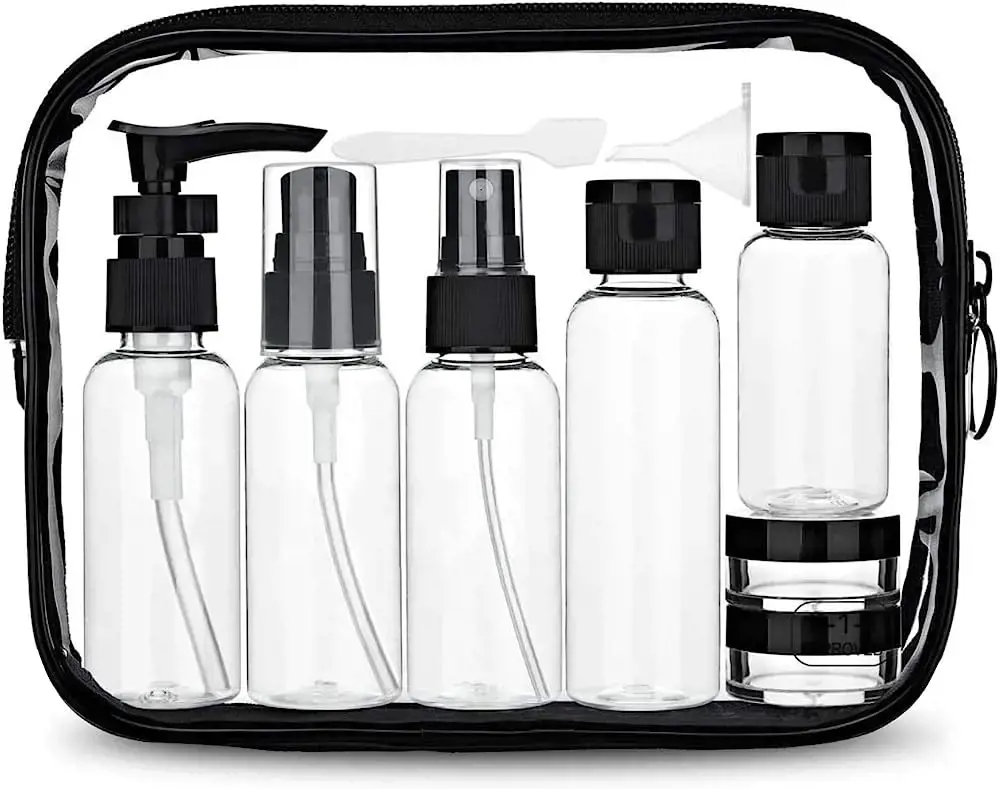
Yes, you can bring travel-sized toiletries on an international flight. However, there are certain rules and regulations that you need to follow to ensure smooth security checks and to comply with airline regulations.
When it comes to toiletries in your carry-on luggage, the Transportation Security Administration (TSA) has specific guidelines that you must adhere to. According to the TSA, all liquids, gels, aerosols, creams, and pastes must be in containers that are 3.4 ounces (100 milliliters) or less. These containers should be placed in a clear, quart-sized, zip-top bag. Each passenger is allowed only one bag of this size, which should be placed in a separate bin during the screening process.
It's important to note that all containers should fit comfortably in the bag and the bag must be completely closed. If a container is larger than the allowed size, it will be confiscated at the security checkpoint, so make sure to double-check the sizes of your travel-sized toiletries before boarding the flight.
Furthermore, if you are carrying any medications or special items like baby formula or breast milk, you are allowed to exceed the 3.4-ounce limit. However, you must declare these items to the security officers and they may need to be inspected separately.
Remember that these rules apply to your carry-on luggage. If you're planning to pack larger sizes of toiletries in your checked luggage, there are usually no restrictions. However, it's always a good idea to check with your airline or the specific countries you are traveling to as they may have their own regulations.
Additionally, it's worth mentioning that if you're traveling to multiple countries, each country may have its own rules and restrictions regarding the transportation of liquids. Therefore, always check the specific regulations of each country you plan to visit to ensure a hassle-free journey.
In summary, you are allowed to bring travel-sized toiletries on an international flight as long as they meet the TSA guidelines of being 3.4 ounces or less and are placed in a quart-sized, zip-top bag. Make sure to declare any medications or special items and check the regulations of both your airline and the countries you are traveling to. By following these rules and being well-prepared, you can easily bring your essential toiletries with you on your international journey.
Navigating Playa del Carmen Travel Restrictions: What You Need to Know
You may want to see also

Are there any specific restrictions on the size or amount of liquids allowed in carry-on luggage?
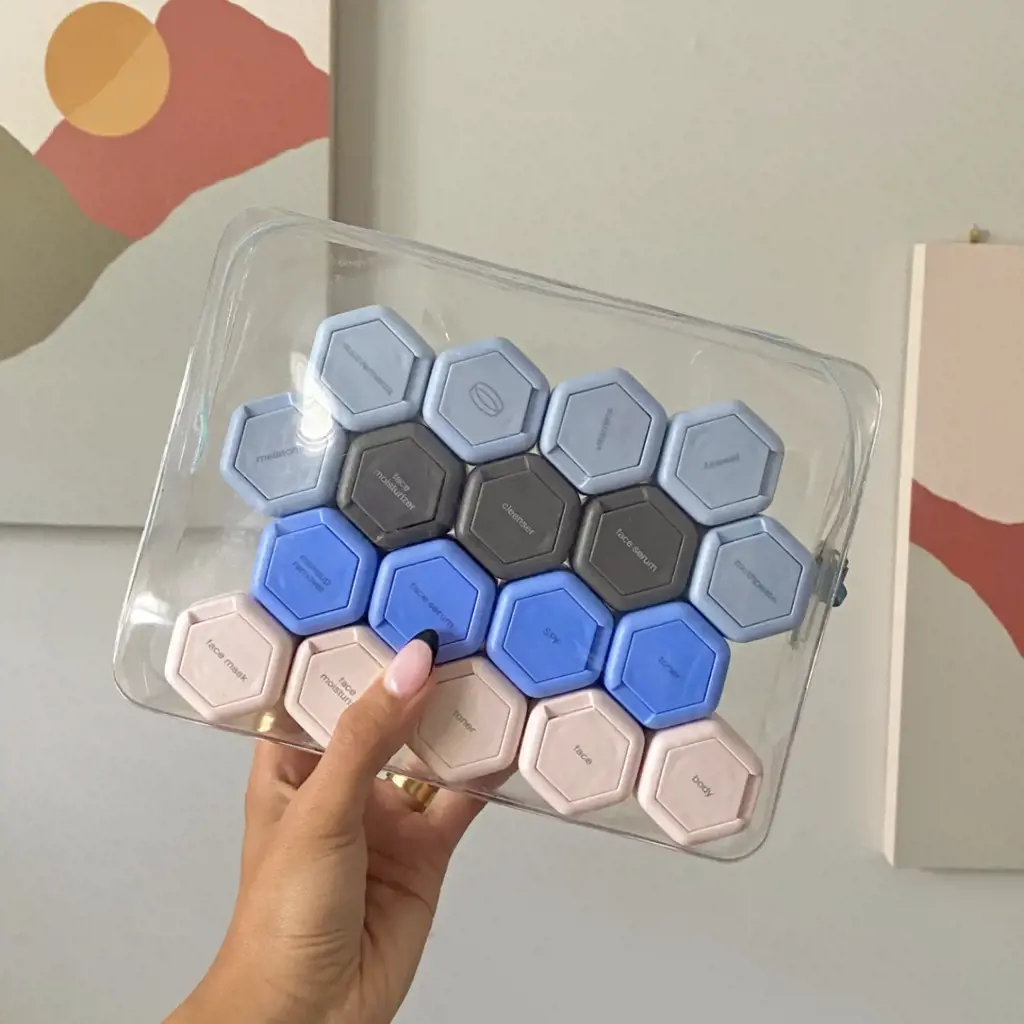
When traveling by air, one of the most common questions travelers ask is about the restrictions on liquids in carry-on luggage. This is an important topic to understand, as not following the rules could result in your liquids being confiscated at the security checkpoint.
The Transportation Security Administration (TSA) sets the guidelines for liquids in carry-on luggage in the United States. These guidelines apply to both domestic and international flights departing from U.S. airports. The rules are designed to ensure the safety of passengers and to prevent the threat of liquids being used as explosive devices.
According to the TSA's 3-1-1 rule, passengers are allowed to bring small amounts of liquids in their carry-on luggage. Each passenger is limited to containers that are 3.4 ounces (100 milliliters) or less. These containers must be placed in a clear, quart-sized plastic bag. Each passenger is only allowed one bag, and the bag must be removed from your luggage and placed separately in a security bin for screening.
The 3-1-1 rule stands for:
- 3: Each passenger is limited to containers that are 3.4 ounces (100 milliliters) or less.
- 1: All the containers must fit in a clear, quart-sized plastic bag.
- 1: Each passenger is only allowed one bag.
It's important to note that the 3-1-1 rule applies to all types of liquids, including water, shampoo, toothpaste, and even gels and aerosols. This means that if you have a bottle of water that is larger than 3.4 ounces, you will need to either drink it before going through security or pack it in your checked luggage.
There are, however, a few exceptions to the 3-1-1 rule. Medications, baby formula, breast milk, and food for infants and toddlers are allowed in reasonable quantities exceeding 3.4 ounces. These items should be declared to the security officer for inspection.
If you have larger quantities of liquid that you need to bring with you, such as full-size bottles of shampoo or contact lens solution, it is recommended that you pack them in your checked luggage. There are no restrictions on the amount of liquids you can pack in your checked luggage, as long as they are not hazardous materials.
It's also worth noting that the 3-1-1 rule only applies to carry-on luggage. There are no restrictions on the size or amount of liquids you can bring in your checked luggage. However, it's always a good idea to check with your airline for any specific rules or regulations they may have regarding liquids in checked luggage.
In conclusion, there are specific restrictions on the size and amount of liquids allowed in carry-on luggage. The TSA's 3-1-1 rule limits passengers to containers that are 3.4 ounces or less and must be placed in a clear, quart-sized plastic bag. Exceptions are made for medications, baby formula, breast milk, and food for infants and toddlers. It's best to pack larger quantities of liquids in your checked luggage, where there are no restrictions on size or amount. Always check with your airline for any additional rules or regulations.
Exploring Montreal: A Guide to Current Travel Restrictions from the US
You may want to see also

How do travel size restrictions differ for checked luggage versus carry-on luggage?
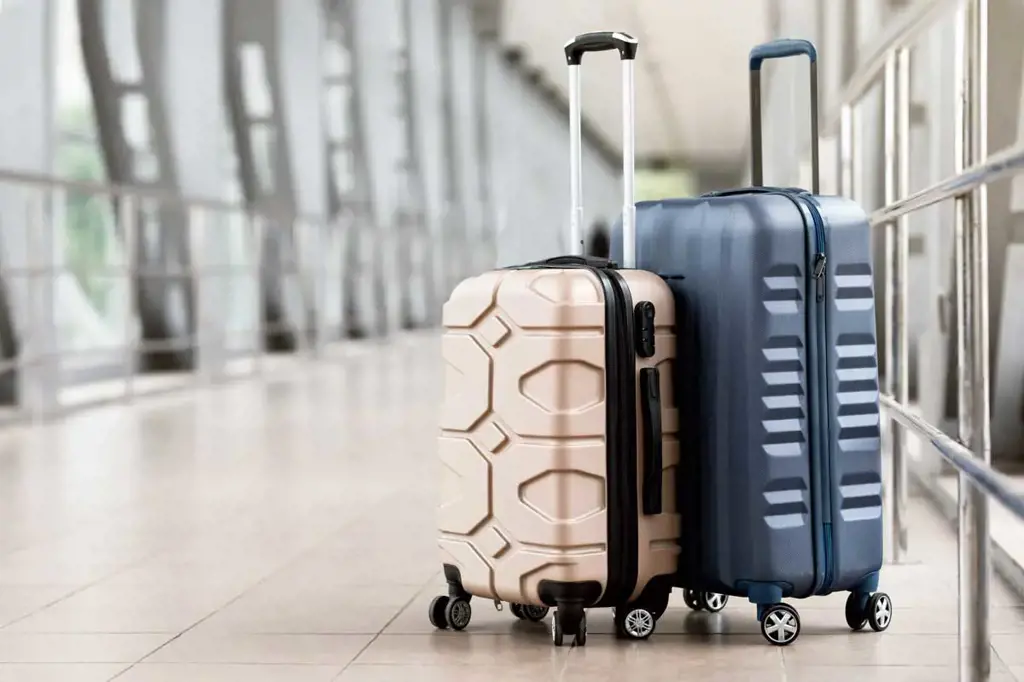
When it comes to traveling, it's important to be aware of the different size restrictions for both checked luggage and carry-on luggage. Airlines have specific regulations in place to ensure a safe and efficient travel experience for all passengers. Understanding these restrictions can help you avoid any issues or additional fees at the airport.
Checked luggage refers to the bags that you hand over to the airline at the check-in counter and are then stowed away in the cargo hold of the plane. The maximum size and weight for checked bags may vary depending on the airline, but the general rule of thumb is that the dimensions should not exceed 62 linear inches (length + width + height) and the weight should not exceed 50 pounds. However, it's always a good idea to check with your specific airline for their exact requirements.
Carry-on luggage, on the other hand, refers to the bags that you bring onto the plane with you and stow in the overhead bins or beneath the seat in front of you. These bags are meant to be smaller and more manageable, as you'll need to keep them with you throughout the flight. Most airlines have similar size restrictions for carry-on bags, with a maximum size of around 22 x 14 x 9 inches and a weight limit of around 40 pounds. Again, it's important to check with your airline for their specific regulations.
It's worth noting that there may be additional restrictions for certain types of items, such as liquids, gels, and sharp objects. These restrictions apply to both checked and carry-on bags and are in place for security reasons. In general, liquids and gels must be in containers of 3.4 ounces (100 milliliters) or less and must be placed in a clear, quart-sized bag. Sharp objects, such as knives or scissors, should be placed in checked bags to comply with safety regulations.
Some airlines also have restrictions on the number of bags you can bring, regardless of size. For example, you may be allowed one carry-on bag and one personal item, such as a purse or laptop bag. Checked bag allowances may vary depending on your ticket class or frequent flyer status.
It's important to note that these size and weight restrictions can vary between airlines, so be sure to check with your specific airline before you travel. If your bag exceeds the allowed dimensions or weight, you may be subject to additional fees or be required to check your bag at the gate.
In conclusion, travel size restrictions differ for checked luggage and carry-on luggage. Checked bags have larger size and weight allowances but are stored in the cargo hold of the plane. Carry-on bags are smaller and must be kept with you throughout the flight. It's crucial to be aware of these restrictions to avoid any issues or additional fees at the airport.
Navigating the Rhode Island Travel Restrictions: What You Need to Know
You may want to see also
Frequently asked questions
The travel size restrictions for liquids on airplanes are defined by the Transportation Security Administration (TSA). According to their regulations, passengers are allowed to bring liquids in containers that are 3.4 ounces (100 milliliters) or less, and all containers must fit in a clear, quart-sized plastic bag. Each passenger is limited to one quart-sized bag.
No, the restrictions apply to the size of the container, regardless of how much liquid is in it. If the container is larger than 3.4 ounces (100 milliliters), even if it is only partially filled, it is not allowed in your carry-on luggage.
There are a few exceptions to the travel size restrictions for liquids. Prescription medications, baby formula, breast milk, and liquids or gels for medical purposes are allowed in larger quantities, but they must be declared and undergo additional security screening. Additionally, duty-free liquids purchased at an airport or on a flight are allowed in carry-on luggage, as long as they are properly sealed in a security tamper-evident bag with proof of purchase.
Yes, you can bring larger quantities of liquids in your checked luggage. The travel size restrictions for liquids only apply to carry-on baggage. However, it is always a good idea to check with the airline you are traveling with for any specific restrictions or limitations they may have on liquids in checked luggage.







